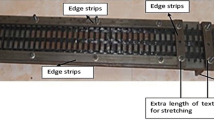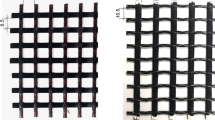Abstract
Textile reinforced concrete(TRC, for short) allows the low size production and offers a high effectiveness of the reinforcement by using continuous roving instead of short-chopped fibers. However, whether textiles can cooperate with concrete very well depends on the bond between them. In this paper, the bonding mechanism that the stress was transferred from fine concrete to textile was analyzed, and the influences of the initial bond length of textile, the surface treatment of textile, the strength and workability of concrete as well as the level of prestressing force on bond behavior were investigated on the basis of pull-out tests. The results reveal that with initial bond length increasing, the maximum pull force increases, and increasing concrete strength and improving workability of concrete matrix, epoxy resin impregnating and sand covering of textile as well as prestressing textile can obviously increase the bond strength between the textile and concrete.
Similar content being viewed by others
References
H-W Reinhardt, M Krüger. Vorgespannte Dünne Platten aus Textilbeton[C]. Textilbeton-1. Fac-kolloquium der Sonderforsc hungsbereiche, 528 und 532, Aachen, 2001:165–174
M Molter, J Hegger, W Habel, et al. Characterization of Bond Performance of Textiles in Cement-Matrices Using Fiber-Optic Sensors[C]. Proceedings of SPIE, 2002, 4694:253–258
H G Maas, U Hampel, M Schulze. Photogrammetrische and Computertomographische Erfassung von Eformationen, Rissentwichlungen und Strukturveränderungen bei Belastungsversuchen von textilverstärkten Probekörpern[C]. Proceedings of the 2nd Colloquium on Textile Reinforced Structures(CTRS2), Dresden, 2003: 187–200
S L Xu, M Krüger, H-W Reinhardt, et al. Bond Characteristics of Carbon, Alkali Resistant Glass and Aramid Textiles in Mortar[J]. Journal of Materials in Civil Engineering, ASCE, 2004, 16(4): 356–364
N Nagamoto, K Ozawa. Mixture Proportions of Self-compacting High-performance Concrete[C]. High-performance Concrete: Design and Materials and Advances in Concrete Technology, ACI SP-172,1997: 623–636
H Okamura, K Ozawa. Mix-design for Self-compacting Concrete[J]. Concrete Library of JSCE,1995, 25: 107–120
K Ozawa, N Sakata, H Okamura. Evaluation of Selfcompactability of Fresh Concrete Using the Funnel Test[J]. Concrete Library of JSCE,1995, 25: 59–75
A Peled, A Bentur. Mechanisms of Fabric Reinforcement of Cement Matrices: Effect of Fabric Geometry and Yarn Properties[C]. Proceedings of the 2nd Colloquium on Textile Reinforced Structures (CTRS2),Dresden,2003
M Konrad, R Chudoba, K Meskouris, et al. Numerical Simulation of Yarn and Bond Behavior at Micro-and Messo-Level[C]. Proceedings of the 2nd Colloquium on Textile Reinforced Structures (CTRS2),Dresden,2003
H T Ren. Study on Basic Theories and Long Time Behavior of Concrete Structures Strengthened by Fiber-Reinforced Polymers[D].Dalian: Dalian University of Technology, 2003
Author information
Authors and Affiliations
Corresponding author
Additional information
Funded by the Key Program of the National Natural Science Foundation of China(No.50438010)
Rights and permissions
About this article
Cite this article
Xu, S., Li, H. Bond properties and experimental methods of textile reinforced concrete. J. Wuhan Univ. Technol. 22, 529–532 (2007). https://doi.org/10.1007/s11595-006-3529-9
Received:
Accepted:
Issue Date:
DOI: https://doi.org/10.1007/s11595-006-3529-9




